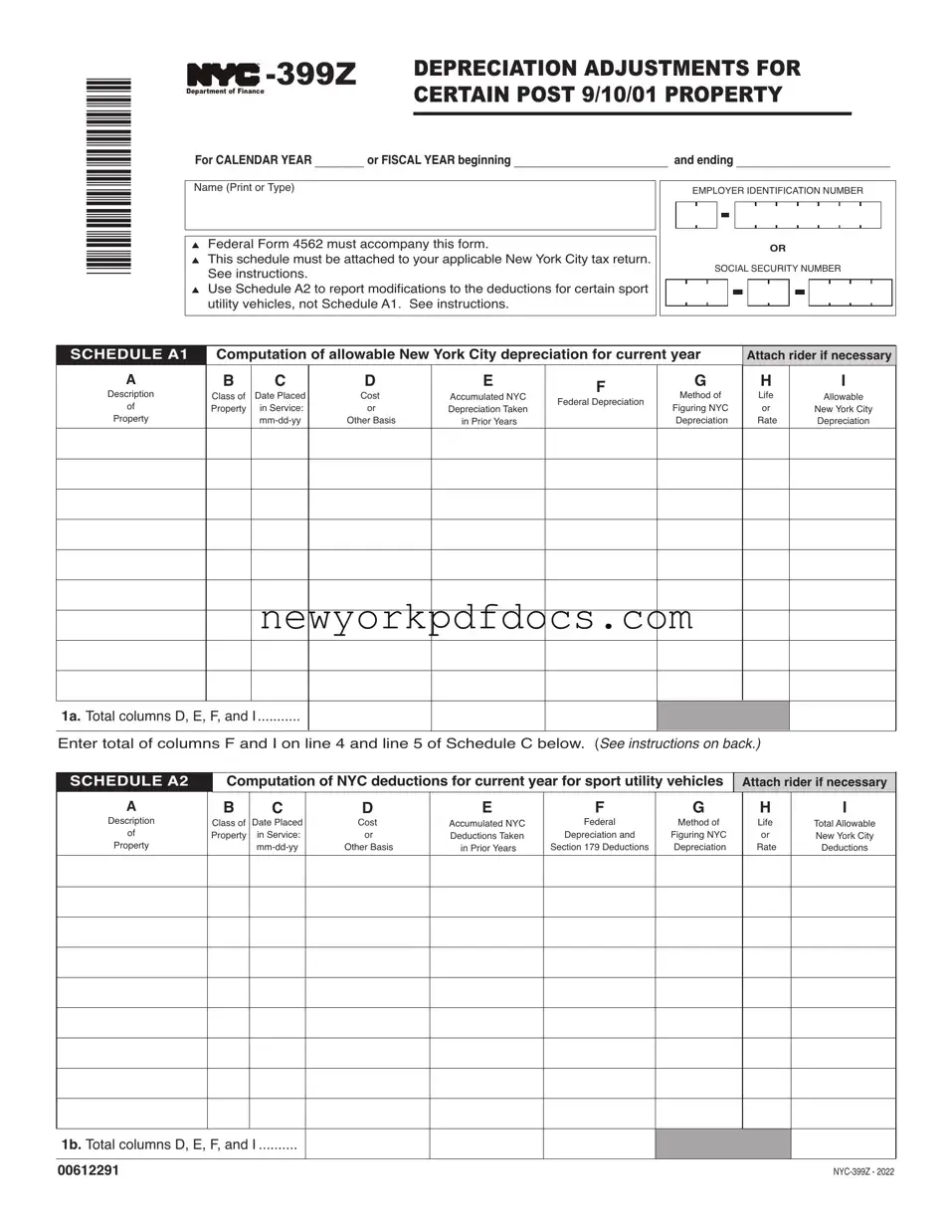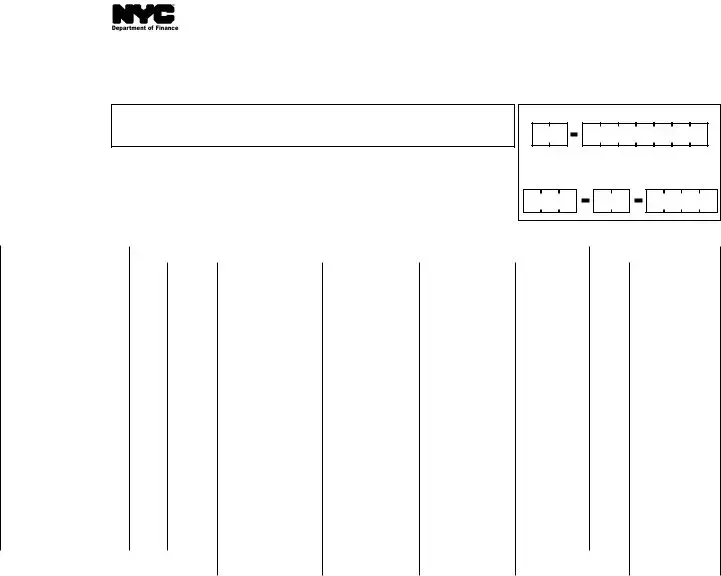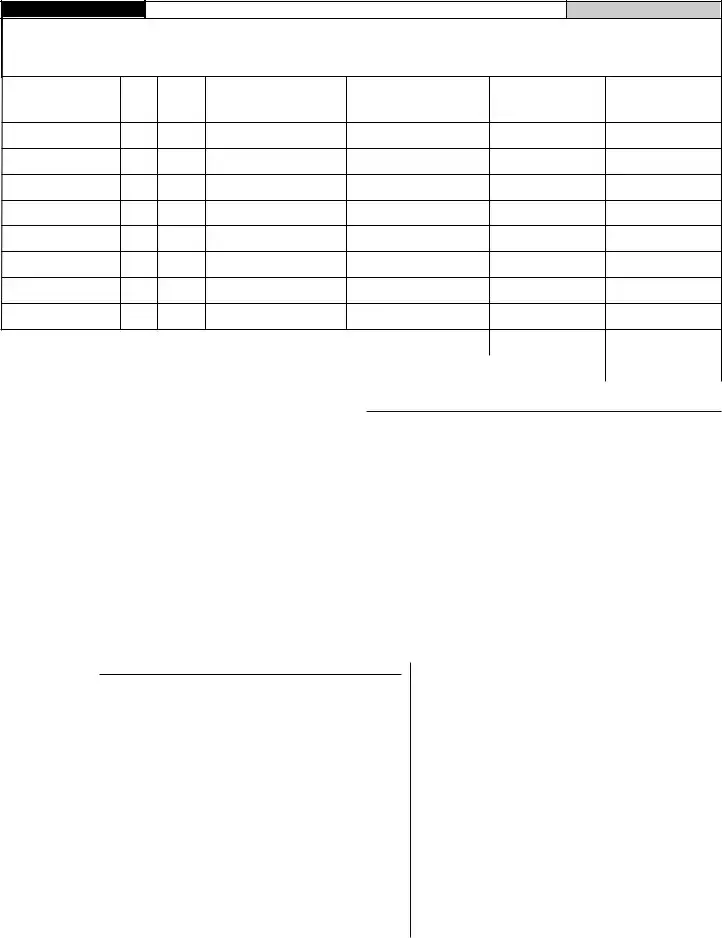|
ColumnG |
total amount that may be deducted for New |
|
Indicate the depreciation method selected for |
York City purposes in the current tax year for |
|
the computation of the New York City allow- |
an SUV subject to the special provisions. See |
|
able depreciation deduction.Any method used |
Finance Memorandum 22-1, “Application of |
|
to compute depreciation that would have been |
IRC §280F Limits to Sport Utility Vehicles”. |
|
allowed under IRC §167, had the property been |
|
|
|
|
|
acquired on September 10, 2001, will be ac- |
SCHEDULE B |
|
ceptable. This includes such methods as |
|
|
|
|
|
straight-line depreciation, declining balance |
Column A |
|
|
depreciation, sum-of-the-years-digits method |
Enter each item of property disposed of during |
|
or any other consistent method. |
the taxable year separately.Attach a rider if ad- |
|
|
ditional room is needed. |
|
Column I |
|
|
|
|
|
Enter depreciation computed by the method in- |
Column D |
|
|
dicated in column G computed as IRC §167 |
Enter for each item of property the total amount |
|
would have applied had the property been ac- |
of federal deductions used in the computation |
|
quired on September 10, 2001. Total of this |
of prior years’ federal taxable income. For an |
|
column will be the amount allowable as a de- |
SUV subject to the special provisions, the |
|
duction for New York City. |
amount entered in Column D should include |
|
any amount deducted under section 179 of the |
|
|
|
LINE 1a |
Internal Revenue Code. |
|
|
|
|
|
|
Enter total of columns F and I on lines 4 and 5 |
Column E |
|
|
of Schedule C, as indicated. |
|
|
Enter for each item of property the total amount |
|
|
|
If you have disposed of “qualified property” |
of New York City deductions used in the com- |
|
other than “qualified Resurgence Zone prop- |
putation of prior years’ New York City entire |
|
erty,” in any year after the year of acquisition, |
net income. |
|
|
you must complete Schedule B. |
Column F |
|
|
|
|
|
SCHEDULEA2 |
For any item of property, if column D exceeds |
|
column E, subtract column E from column D |
|
|
|
ColumnA |
and enter the excess in this column. |
|
|
|
|
|
|
Enter the year, make and model for each SUV. |
Column G |
|
|
ColumnB |
For any item of property, if column E exceeds |
|
column D, subtract column D from column E |
|
Indicate the property class type used or that |
|
and enter the excess in this column. |
|
would be used in computing federal deprecia- |
|
|
|
|
|
tion for each SUV. |
LINE 2 |
|
|
|
|
|
|
|
|
|
ColumnD |
Add the amounts in column F and enter the |
|
total on line 2 and on Schedule C, line 7a. |
|
The amount entered in this column must be |
|
|
|
|
|
|
equal to the cost or other basis used for federal |
LINE 3 |
|
|
|
|
purposes prior to any special depreciation al- |
Add the amounts in column G and enter the |
|
lowances for qualified property and prior to the |
total on line 3 and on Schedule C, line 7b. |
|
expense in lieu of depreciation deduction al- |
|
|
|
|
|
lowed under section 179 of the Internal Rev- |
SCHEDULE C |
|
enue Code. |
|
|
|
|
|
|
LINE 8 |
|
|
|
|
ColumnE |
Enter the amount on line 8A as an addition on |
|
Enter the total New York City depreciation |
the applicable New York City tax return. Use |
|
taken in prior years including, for years prior |
the following lines. Attach an explanation. |
|
to 2018, the amount of any deduction taken |
|
|
|
|
|
under section 179 of the Internal Revenue |
NYC-3A- Schedule B, line 6c* |
|
Code for New York City purposes. |
NYC-3L - |
Schedule B, line 6c |
|
|
|
ColumnF |
NYC-4S |
- |
Schedule B, line 4 |
|
For each SUV, enter the sum of the amount of |
NYC-202 |
- |
Schedule B, line 10c |
|
the federal depreciation deduction taken and |
NYC-202EIN - Schedule B, line 10c |
|
amount of any federal expense in lieu of de- |
|
preciation deduction taken under section 179 |
NYC-204 |
- |
Schedule B, line 14c |
|
of the Internal Revenue Code for the current |
NYC-1 |
- |
Schedule B, line 8 |
|
tax period. |
NYC-2 |
- |
Schedule B, line 11 |
|
|
|
ColumnI |
NYC-2A - Schedule B, Line 11** |
|
The amount entered in column I should be the |
NYC-2S |
- |
Schedule B, Line 6 |





